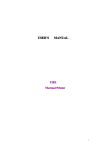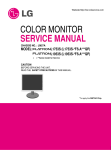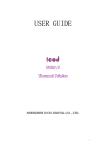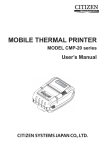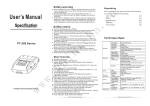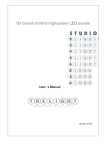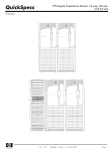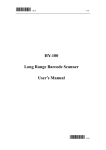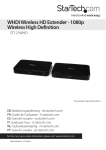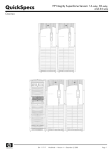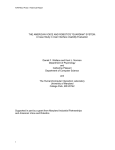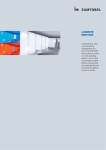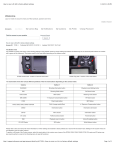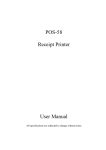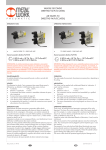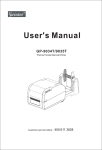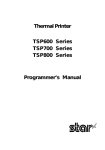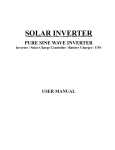Download USER`S MANUAL
Transcript
USER’S MANUAL ICOD FTP 628A Shenzhen ICOD Digital Co., Ltd. 1 DECLARE § The content of this document limited to free change without permission, Shenzhen ICOD Digital Co., Ltd. reserves the right to improve products on software and hardware. If the user needs further information about products, please contact Shenzhen ICOD Digital Co., Ltd. and authorized distributors. §No part of this document may be reproduced or transmitted in any form or by any means, without the written permission of Shenzhen ICOD Digital Co., Ltd. COPYRIGHT ----- This document made by 2006 ----- Copyright: belongs to Shenzhen ICOD Digital Co., Ltd. ----- Edition: 1.0 <2006.12> 2 Security Information In order to use your printer in effectiveness and security, Please obey the following rules. →Before Use ● In order to hold the right use method, before using printer, please read this user’s manual particularly. ● Please put this 《User’s Manual》on the convenient position, In order to take out reading and solving problems at any moment. →Notes In Security If neglect the following notice matters, incorrect use may be bring damage. NOTES ◇ Please don’t set this product in the humid or dusty environment. ◇ No pressing, No dumping. ◇ Do not impose the electric current and voltage over the biggest absolute fixed value on any pin, If over the normal voltage or the electric current, the equipment will be brought heat damage. ◇ Make sure that the connection equipment uses the specific cables, Incorrect connection should be brought losing fire or striking fire. ◇ Any electric material prohibited to fall on the circuit board, the pin on the short circuit board may be bring heat damage because of the over electric current. 3 TABLE OF CONTENTS Chapter Ⅰ Introduction ..................................................................................................... 6 1.1 Technique Specification........................................................................................ 6 1.2 Printing Character ................................................................................................ 6 1.3 Interface Form...................................................................................................... 6 1.4 Control Command................................................................................................ 6 1.5 Power and Operating Environment Request........................................................ 7 1.6 Dimension and Weight(the host control board) .................................................... 7 Chapter Ⅱ Installation and Operation ............................................................................... 8 2.1 General Structure................................................................................................. 8 2.2 PCB Installation Method....................................................................................... 9 2.3 System Installation and Operation ....................................................................... 9 2.3.1 Power connection ...................................................................................... 9 2.3.2 Print head connection .............................................................................. 10 2.4 Interface Connection.......................................................................................... 10 2.4.1 RS-232 serial interface ............................................................................ 10 2.5Key Operation and Light ......................................................................................11 2.5.1Feed paper button......................................................................................11 2.5.2Light ...........................................................................................................11 2.6 Special working mode .........................................................................................11 2.6.1 Self-test.....................................................................................................11 Chapter Ⅲ Print Table..................................................................................................... 12 3.1 Command Illustration ......................................................................................... 12 3.2 The specific printing command .......................................................................... 12 3.2.1 Printing command .................................................................................... 12 LF .............................................................................................................. 12 ESC J n ..................................................................................................... 13 3.2.2 Setting command for line spacing ............................................................ 13 ESC 2 ........................................................................................................ 13 ESC 3 n ..................................................................................................... 13 3.2.3 Character printing command.................................................................... 13 ESC ! n ...................................................................................................... 13 ESC % n .................................................................................................... 14 ESC & s n m .............................................................................................. 14 3.2.4 Special Control Command ....................................................................... 14 ESC c 5 n .................................................................................................. 15 3.2.5 Dot Graphics Printing Command ............................................................. 15 ESC * m n1 n2 d1......dk ............................................................................ 15 GS / n ........................................................................................................ 16 GS * n1 n2 d1......dk .................................................................................. 17 3.2.6 Bar code command.................................................................................. 17 4 GS w n....................................................................................................... 17 GS h n ....................................................................................................... 18 GS k m d1......dk NUL................................................................................ 18 GS k m n d1......dn..................................................................................... 18 3.2.7 Other commands ..................................................................................... 20 ESC @....................................................................................................... 20 ESC v ........................................................................................................ 20 GS V m ...................................................................................................... 21 GS V m n ................................................................................................... 21 DLE EOT n ................................................................................................ 21 DLE ENQ n................................................................................................ 24 Appendix Ⅰ: CODE128 bar code ................................................................................... 24 5 Chapter Ⅰ Introduction 1.1 Technique Specification Note: At present FTP 628A only supports FTP-628MCL354 print head, the parameter in the following table measured only on the condition of using this print head. Item Parameter Supporting Print Head FTP-628MCL354 Printing Mode Thermal line printing Printing Speed 50 ㎜/second Printing Width 57.5±0.5 ㎜ Printing Density 8dot/㎜, 384dot/line Effective Printing Width 48 ㎜ Paper Solve Method Auto cut Detestation of Without Paper Photo electricity Sensor Life of Print Head 50KM Life of Auto cutter 300000 1.2 Printing Character Item Parameter ANK Print font 12×24dot, 1.2(width)×3.00(height)㎜ International Standard Ⅰ ﹑ⅡClass Chinese font 24×24dot 3.00(width) ×3.00(height)㎜ 1.3 Interface Form Item Serial Interface Parameter Support RTS/CTS; Baud rate: 9600bps Data-base: 1 start bit +8 data bits +1 bit or more than 1 stop bit 1.4 Control Command 6 Item Parameter Dot Printing Command Support different density dot and load graphics printing Character Command Support ANK character, user defined character and Chinese characters double width printing, double height printing, the gap of the characters are adjustable Printing 1.5 Power and Operating Environment Request Item Parameter Power Supply DC7.5V~8.5V, 3A Operating Temp. 0~55 Operating Humidity Relative 10~80% Storage Temp. -25~70℃ Storage Relative Humidity 0~90% 1.6 Dimension and Weight (control board) Item Parameter Length 100 ㎜ Width 70 ㎜ Height 13 ㎜ Weight 34g 7 Chapter Ⅱ Installation and Operation 2.1 General Structure Figure 2.1.1 control board 8 Figure 2.1.2 Connecting board 2.2 PCB Installation Method In order to install FTB628A control board on the case, the designable case must be met the following requirements. ● Between the above of electrolytic condenser which on the FTB628A1 control board and case, be sure there are 3 ㎜ or more space. ● Be sure the installation pin of FTB628A have 5 ㎜ or more space, the figure as follows: ● Fix the FTB628A control board on the mental case. 2.3 System Installation and Operation 2.3.1 Power connection 9 Power requirement: DV 7.5V~8.5V 3A Power Socket: There are installing power connection socket CN4 on the board, connecting as the figure of 2.1.1. 2.3.2 Print head connection At present only support FTP628A, About the specific connection, please refer to the structural figure. At the process of the actual installation, if the length of the printer head cable is not enough, please use connection board. The using steps about connecting board 1. Connect control board with connecting board, the socket of connecting board 30 pin is the printer head cable connecting socket, 4 pin socket is the connecting socket of cutter cable. 2. Connect printer head with connecting board well, the method as the above step. 2.4 Interface Connection 2.4.1 RS-232 serial interface Data transmission: Serial Synchronization manner: Asynchronous Handshaking signal: CTS/RTS Signal level: MARK=-3 to -15V Baud rate: 9600bps (bps: bits per second) Date word length: 8 bit fixed Check-out manner: No Stop bits: 1 bit or more than 1 bit Socket (side of the printer): 4Pin socket The assignments of the interface socket pin as the following table: Pin Signal Name Signal Source Illustration 1 TXD Printer Transmit data 2 RTS The host computer Receive data 3 DTR Printer Could data 4 GND Connecting with PC as the following figure: (Printer)DB4 IBMPC DB9 ---------DB25 receive Logically IBMPC DB25 10 The connection figure of printer serial interface and PC serial interface 2.5Key Operation and Light 2.5.1Feed paper button In the general mode, press the feed paper button, printer moves paper ahead. In the following circumstances, press feed paper button, it won’t move paper ahead. ① Uses ESC c 5 command and prohibits the function of the button. ② Paper-end sensor test without paper. Note: ESC c 5 can permit/prohibit the function of the button, when pressing button and prohibiting it, the button is ineffective. 2.5.2Light Without paper, PE light is bright, when occur over temp and incorrect cut paper, ERROR light flashed. 2.6 Special worke mode 2.6.1 Self-test Self-test can test whether the printer is normal or not, If it can print self-test list correctly, That’s to say, all the functions of the printer in normal condition except for the interface of the host computer. Or, it needs to examine and repair. Start-up self-test: Installed paper, First press the feed paper button on the off-electric condition, then turn power button on, and loosen feed paper button in 5 seconds, printer entered into self-test mode, and print self-test list. 11 Chapter Ⅲ Print Table 3.1 Command Illustration Command Illustration LF Print and change a new line ESC J n Print and feed paper n dot lines ESC 2 n Set character line spacing 1/6 feet ESC 3 n Set line spacing n dot lines(n/203 feet) ESC ! n Set character printing method ESC % n Permit/prohibit user-defined character ESC & s n m Set user-defined character ESC c 5 n Permit/prohibit pressing button command ESC * m n1 n2 d1......dk Set dot command ESC * n1 n2 d1......dk Defined load dot GS / n Print load dot GS w n Set bar code width GS h n Set bar code height ① GS k m d1......dk NUL ② GS k m n d1......dn Print bar code ESC @ Initialization ESC v Send printing status to the host computer ESC v m Choose the method of cut paper and cut and send paper DLE EOT n Transmit real-time status DLE ENQ n Send real-time request to printer 3.2 The specific printing command 3.2.1 Printing command LF Print and change a new line Form ASCⅡ: LF DECIMAL: 10 HEX: Description 0A Printing content in the line buffer and move one paper line ahead, when line buffer is empty, only moving one line ahead 12 ESC J n Print and feed paper n dot lines ASCII: ESC form DECIMAL: 27 HEX: 1B Description J n 74 n 4A n Printing content in the line buffer and move n dot lines ahead(n/203feet) n=0~255 This orders only effected to this line, not change the line spacing which set by ESC 2, ES 3 command 3.2.2 Setting command for line spacing ESC 2 Set character line spacing 1/6 feet ASCII: ESC 2 Form DECIMAL: 27 50 HEX: 1B 32 Set line spacing 1/6 feet ESC 3 n Set line spacing n dot lines(n/203 feet) ASCII: ESC 3 n Form DECIMAL: 27 51 n HEX: 1B 33 n Description Set line spacing n dot lines. n =0~255 This orders set line spacing n/203 feet. Default value: n=30 3.2.3 Character printing command ESC ! n Set character printing pattern Form ASCII: ESC ! n DECIMAL: 27 33 n HEX: 1B 21 n Description Set line spacing n dot lines. n =0~255 ESC ! n is a comprehensive character printing pattern setting orders, be used to choose the size of printing character. The default value of n is 0, 13 that’s to say, character isn’t be extended. The definition of per printing parameter n as follows: 1: Double height printing 1: Double height printing ESC % n Permit/prohibit user-defined character ASCII: ESC % n Form DECIMAL: 27 37 n HEX: 1B 25 n Description When n =1, choose user-defined character fond; when n =0, choose interior character fond Default value n =0 ESC & s n m Set user-defined character Form Description ASCII: ESC & S n m 〔a〔p〕s×a〕m-n+1 DECIMAL: 27 38 S n m 〔a〔p〕s×a〕m-n+1 HEX: 1B 26 S n m 〔a〔p〕s×a〕m-n+1 ESC & be used to define user-defined character. S=3, 32≤n≤m≤126 0≤a≤12, 0≤p≤255. s means the vertical bits, here s=3, n means the started ASCII code of user-defined character m means the end ASCII code of user-defined character, when only defining one character, takes n=m, could define at the most of 96 user-defined character a means level dot counts; p means user-defined character data, per character s×a bytes, together defined m-n+1 characters. After defining, the user-defined character always effects, till defining again or reposition or turn off print. 3.2.4 Special Control Command 14 ESC c 5 n Permit/prohibit pressing button command ASCII: ESC c 5 n Form DECIMAL: 27 99 53 n HEX: 1B 63 35 n Description When n=1, prohibit that the paper carrier button effects When n=0, permit that the paper carrier button effects, Default value is n=o 3.2.5 Dot Graphics Printing Command ESC * m n1 n2 d1......dk Set dot command Form ASCII: ESC * m n n1 n2 〔d〕k DECIMAL: 27 42 m n n1 n2 〔d〕k HEX: 1B 2A m n n1 n2 〔d〕k Description Set dot graphics pattern(takes m), dot counts(takes n1,n2) and dot graphics content (takes 〔d〕k) m=0, 1, 32, 33. n1=0~255, n2=0~3. d=0~255 K=n1+256×n2(m=0,1); k=(n1+6×n2) ×3(m=32,33) Level dot counts is n1+256×n2 If the dot counts over one line, the part which over the biggest dot count will be neglected(connected with the chosen dot graphics pattern, the specifics as the following table) □ d is dot graphics data byte, relevant dot is 1, which means that this dot should be printed; relevant dot is 0, which means that this dot shouldn’t be printed. □ m be used to choose dot graphics pattern. 15 M Vertical Mode Horizontal Dot coun t Dot density Dot density The most of dot counts 0 8 dot single density 8 68 DPI 101 DPI 192 1 8 dot double density 8 68 DPI 203 DPI 384 32 24 dot single density 24 203 DPI 101DPI 192 33 24 dot double density 24 203 DPI 203DPI 384 8 dot pattern 24 dot pattern Dot graphics data(bit graphic) graphic) Dot graphics data(bit GS / n Print load dot ASCII: Form Description GS / DECIMAL: 29 47 DEX: 1D 2F n n n This orders be used to print load dot. n=0~3 n be used to choose dot graphics pattern: could use GS * command to define dot graphics n Dot graphics pattern Veridical density Horizontal density 0 Normal pattern 203 DPI 203 DPI 1 Double width pattern 203 DPI 101 DPI 16 2 Double height pattern 101 DPI 203 DPI 3 Double height width pattern 101 DPI 101 DPI and GS * n1 n2 d1......dk Defined load dot ASCII: GS Form DECIMAL: 29 HEX: 1D Descriptio n * n1 n2 〔d〕k 42 n1 n2 〔d〕k 2A n1 n2 〔d〕k This orders be used to define load dot n 1=1~48, n2=1~255, n1×n2<1200, k=n1×n2×8 d is the dot graphics data; horizontal n1×8 dot; vertical n2×8; It always effects after loading dot graphics definition until taking new definition and reposition and recovery 3.2.6 Bar code command GS w n Set bar code width Form ASCII: GS w HEX: 77 n n 17 DECIMAL: Descriptio n 29 119 n □ Set bar code horizontal size, 2≤n≤3 □ n be set the width of bar code as follows: N Bar code 2 Normal 3 Wide bar code □ Support the below bar code: CODE 128, CODE 39, ITF Default value is n =2 Relevant command: GS K GS h n Set bar code height ASCII: Form GS h HEX : 1D DECIMAL : Descriptio n n 68 n 29 104 n □ Set bar code height, 1≤n≤255; □ n be set the vertical dot counts □ Default value is n=50 □ Relevant command: GS K ○1 GS k m d1......dk NUL ○2 GS k m n d1......dn Print bar code ①ASCII code: GS k m d1......dk NUL Form HEX: 1D 6B m d1......dk 00 DECIMAL: 29 107 m d1.......dk 0 ②ASCII code: GS k m n d1......dn HEX: 1D 6B m n d1......dn DECIMAL: 29 107 m n d1......dn Descriptio n □ Choose bar code system and print bar code: ① 4≤m≤5 (k and d decided by using bar code system) ② m=73 (n and d decided by using bar code system) □ m set the bar code system as follows: M Bar code system Character units Notes 18 ① ② 4 CODE39 1≤K 48≤d≤57, 65≤d≤90,32,36,37,43,45, 46,47 5 ITF 1≤K(k is even) 48≤d≤57 73 CODE128 1≤n≤255 0≤d≤127 【Note①】 ·This orders finished by NUL code. ·The units of ITF bar code data must be even. When inputting odd units data, the printer will be neglected the last one which received. 【Note②】 ·n designates bar code data byte counts, and the printer will take n byte date and deal with as the bar code data from the next character. ·If n exceeds the designated scale, then the printer stop dealing with this orders, and treat continued data as the general data. ·This orders feed paper according to the requirement of printing bar code, no consider the line spacing which set by ESC 2 or ESC 3. ·This orders only effects that there are no data in the printing line buffer area. When there are data in the printing line buffer area, the printer will treat continued data as the general data. ·After printing bar code, this orders set the printing position at the beginning of a line. ·This orders no effected by printing pattern(the size of character and so on), except reverse printing pattern. When using CODE128(m=73): ·About the information of CODE128 bar code and code table, please consult appendix Ⅰ. ·When this printer uses CODE128, please consider the below factors which refers to sending the data: ① The head of bar code data must be the chosen character(CODE A,CODE B, or CODE C) of code fond, be used to choose the first used code fond. ② Defined special characters by used “{” and a group of characters, Through sending two “{” definition continually and defined ASCII character “{”. Special character Sending data ASCII code HEX DECIMAL SHIFT { S 7B, 53 123, 83 CODE A { A 7B, 41 123, 65 CODE B { B 7B, 42 123, 66 CODE C { C 7B, 43 123, 67 FNC 1 {1 7B, 31 123, 49 FNC 2 {2 7B, 32 123, 50 19 FNC 3 {3 7B, 33 123, 51 FNC 4 {4 7B, 34 123, 52 7B, 7B, 123, 123 “{” { { ·If the data serial head of bar code is not the code fond chosen character, so the printer stop dealing with command, and treat the continued data as the general data. ·If the combination of “{” and continued characters isn’t fitting for any special characters, so the printer stop dealing with command, and treat the continued data as the general data. ·If the printer can’t receive the characters which should be used to special code fond, so the printer stop dealing with command, and treat the continued data as the general data. 3.2.7 Other commands ESC @ Initialization ASCII: ESC @ Form DECIMAL: 27 64 HEX: 1B 40 Descriptio n ESC @ command initializes the following contents: □ Clear away printing buffer; □ Restore default value; □ Choose character printing pattern; □ Delete user-defined character. ESC v Send printing condition to the host computer ASCII: ESC Form v DECIMAL: 27 118 HEX: 1B Descriptio n 76 Send printing condition to the host computer, only effects serial communication. When the printer received this orders, sending one byte up to printer through serial interface TXD. The definition of per byte as follows: Bit Data Function 0 1 20 0 Undefined ---------- ---------- 1 Undefined ---------- ---------- 2 Paper-test machine With paper Without paper ---------- ---------- 3 Undefined 4 Unused 5 Undefined ---------- --------- 6 Undefined ---------- --------- 7 Undefined ---------- --------- Identical data is 0 Identical data is 0 ○1 GS V m ○2 GS V m n Choose the pattern of cut paper and cut and send paper ASCII: GS V m DECIMAL: 29 86 m HEX: 1D 56 m Form ASCII: GS V m n DECIMAL: 29 86 m n HEX: 1D 56 m n Descriptio n 0≤n≤255 This orders supports two cutting pattern When m=0,1,48,49, printer executes direct cutting paper pattern.(Full cutter or half cutter) When m=66, printer firstly moves the paper ahead(The position of cut/slice paper + n×0.176 ㎜), then cutting paper. ·Execute full cut paper or half cut paper which determined by DIP set. ·This orders only effects when the printing position set at the beginning of the line. ·When chosen black mark is effective, It’s ineffective when execution GS v 66 command, the space of feeding paper ahead which determined by the parameter of GS ( F command. DLE EOT n Transmit real-time status Form ASCⅡ: DLE EOT n DECIMAL: 16 4 HEX: 10 04 n n 21 Description This orders only supports the D5000 serial interface model, after receiving this order, according to the requirement of parameter n, send a relevant byte printer condition to the host computer at once. n took the scale of number 1~4, the relevant printer condition for different n number is: n=1: Printer condition byte n=2: Printer off-line condition byte n=3: Printer breakdown condition byte n=4: Printer paper test condition byte ● When printer send condition byte back, not consider the host computer allow sending date or not, That’s to say, not test interface DSR/CTS signal, send at once when receiving the DLE EOT n order. ● When printer send condition byte back, not consider printer line is off-line or not, receiving buffer is full or not, or whether happen any one of fault. ● The specified definition of the relevant condition byte for different n number as the next tables. n=1: Printer condition Bit Function Datum OFF/ON 0 1 0 Unused 0 --- 1 Unused --- 1 2 Undefined --- --- 3 4 5 Off-line/On-line On-line Unused --- Whether waiting on-line restored or not 6 Undefined 7 Unused Off-line 1 Not waiting on-line restored Waiting on-line restored --- --0 --- n=2: Off-line condition Bit Function Datum OFF/ON 0 1 0 Unused 0 --- 1 Unused --- 1 2 Undefined --- --- 3 Press key feed paper and No feed paper The processing of pressing key 22 and paper 4 Unused 5 Out of paper stop printing 6 In breakdown condition In good condition 7 Unused 0 feeding --- 1 With paper Without paper stop printing Breakdown occurred --- n=3: Breakdown condition Bit Function Datum OFF/ON 0 1 0 Unused 0 --- 1 Unused --- 1 2 Machine breakdown In good condition Machine breakdown occurred 3 Cutter breakdown In good condition Cutter breakdown occurred 4 Unused --- 1 5 The breakdown can’t be restored Any breakdown can be restored The breakdown can’t be restored which have occurred 6 The breakdown can be restored by itself Any breakdown can be restored by itself The breakdown can be restored by itself which have occurred 7 Unused 0 --- n=4: Paper test condition Bit Function Datum OFF/ON 0 1 0 Unused 0 --- 1 Unused --- 1 2.3 4 5.6 Paper will exhaust and switch in test condition Unused Out of paper and switch in test condition With paper --With paper Without paper 1 Without paper 23 7 Unused 0 --- DLE ENQ n Send real-time request to printer Form ASCⅡ: DLE ENQ n DECIMAL: 16 HEX: 10 Description 5 05 n n This order only effects to the D5000 serial model, when receiving this order, according to n parameter stipulation and answer the host computer’s operational request. Parameter n took number 0, 2 n=0: Restore on-line condition n=2: Clear received buffer area and printing buffer area, then restart. ● Receiving this order, answer and execute. ● Only at the process of “wait on-line condition” which set paper by itself. This command (n=0) will be executed, the other condition doesn’t answer this order(n=0). ● Only happened cutter fault, black mark fault, this order (n=2) will be executed, the other condition doesn’t answer this order(n=2). Appendix Ⅰ: CODE128 bar code 1. The description of CODE128 bar code At the CODE128 bar code system, using one bar code character fond, it could indicate 128 units ASCII characters and 2 bit counts. These bar code characters defined by 103 units bar code characters and 3 units code fond , Per code fond indicates the following characters: ·Code fond A: ASCII character 00H to 5FH ·Code fond B: ASCII character 20H to 7FH ·Code fond C: Use one character indicates 2 bits natural characters(100 units numerals from 00 to 99) There are another special characters among CODE128: ·SHIFT character At the code fond A, the code which followed with SHIFT be treated as the code B character. At the code fond B, the code which followed with SHIFT be treated as the code A character. SHIFT character can’t be used at code fond C. ·Code fond chosen character(CODE A, CODE B, CODE C) This character changes the following code fond to code fond A B or C ·Function character(FNC1, FNC2,FNC3,FNC4) The use of function character depends on the application software. At the code fond C, only FNC 1 in practical. 24 Code table Printing character among code fond A Printing character among code fond B 25 Printing character among code fond C 26 27



























